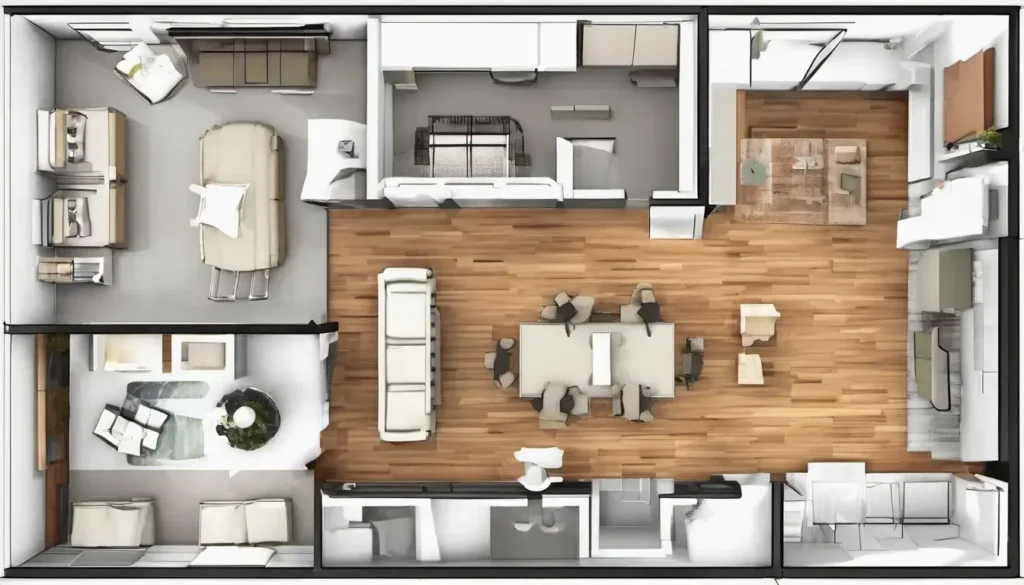Arranging furniture in the living room is not just about aesthetics but also about creating a space that is comfortable and functional for everyday living. Whether you’re moving into a new home or simply looking to refresh your current space, the way you arrange your furniture can make a significant difference.
Assess Your Space
Before diving into rearranging your furniture, take some time to assess your living room space.  Consider the dimensions of the room, the location of windows, doors, and any architectural features that may affect furniture placement. Also, think about the traffic flow in the room and how you want to use the space.
Consider the dimensions of the room, the location of windows, doors, and any architectural features that may affect furniture placement. Also, think about the traffic flow in the room and how you want to use the space.
Create a Floor Plan
Creating a floor plan can help you visualize different furniture arrangements before moving heavy pieces around.  You can sketch it out on paper or use online tools and apps that allow you to input your room dimensions and furniture measurements to create a virtual floor plan.
You can sketch it out on paper or use online tools and apps that allow you to input your room dimensions and furniture measurements to create a virtual floor plan.
Define Functionality Zones
Identify the primary functions of your living room, such as lounging, entertaining, watching TV, or reading.  Then, divide the space into zones based on these functions. For example, you might have a seating area focused around a coffee table for conversation, a media area with a TV and comfortable seating, and a reading nook with a cozy armchair and lamp.
Then, divide the space into zones based on these functions. For example, you might have a seating area focused around a coffee table for conversation, a media area with a TV and comfortable seating, and a reading nook with a cozy armchair and lamp.
Choose a Focal Point
Every living room should have a focal point, whether it’s a fireplace, a large window with a view, or a piece of artwork. Arrange your furniture around this focal point to create a cohesive and visually appealing layout. This will also help anchor the room and give it a sense of purpose.
Consider Traffic Flow
Ensure there is enough space for people to move around comfortably without bumping into furniture or each other. Leave clear pathways between furniture pieces, especially in high-traffic areas like entryways and around seating areas.
Balance Furniture Proportions
Achieve visual balance by mixing furniture pieces of different sizes and shapes. For example, pair a large sofa with smaller accent chairs or balance a bulky entertainment center with delicate side tables. This will create a more dynamic and visually interesting arrangement.
Experiment with Arrangements
Don’t be afraid to experiment with different furniture arrangements until you find one that works best for your space.  Move pieces around, try different angles, and play with the placement of rugs and accessories until you achieve the desired look and feel.
Move pieces around, try different angles, and play with the placement of rugs and accessories until you achieve the desired look and feel.
Furniture Placement Tips
- Place seating at a conversational distance from each other to encourage interaction.
- Use rugs to define different zones within the room.
- Avoid blocking natural light sources like windows with large furniture pieces.
- Leave enough space between furniture and walls for a more open and spacious feel.
Comparison Table
| Arrangement | Pros | Cons |
|---|---|---|
| L-shaped | Maximizes seating capacity | May not work well in smaller rooms |
| U-shaped | Creates a cozy and intimate setting | Requires more floor space |
| Symmetrical | Provides a balanced and formal look | Can feel too rigid and formal |
| Asymmetrical | Offers a more relaxed and eclectic vibe | Requires careful balance to avoid looking cluttered |
FAQs
Q: How do I arrange furniture in a small living room?
A: In a small living room, consider using space-saving furniture like a sectional sofa or a loveseat instead of a bulky couch. Opt for multi-functional pieces like an ottoman with storage or a coffee table that can double as a dining table.
Q: Should I place the TV above the fireplace?
A: It’s not recommended to place the TV above the fireplace as it can strain your neck and cause discomfort when watching for extended periods. Instead, consider mounting the TV on an adjacent wall or placing it on a media console at eye level.
Q: How much space should I leave between furniture pieces?
A: Aim to leave at least 18 inches of space between seating pieces for easy maneuverability. Allow for enough space around coffee tables and other furniture for comfortable movement.
Conclusion
Arranging living room furniture requires careful consideration of space, functionality, and aesthetics. By following the tips and guidelines outlined in this guide, you can create a cozy and functional living room layout that suits your lifestyle and preferences. Remember to experiment with different arrangements until you find the perfect setup for your space. Happy decorating!
